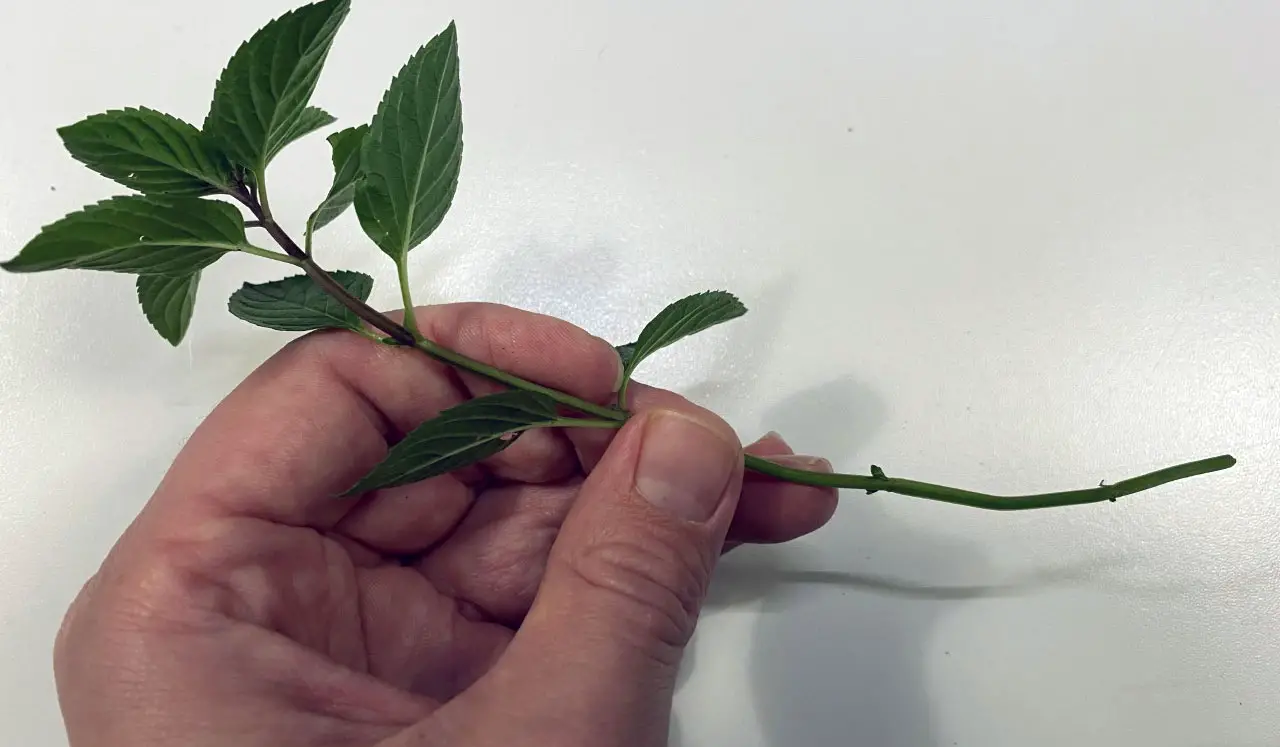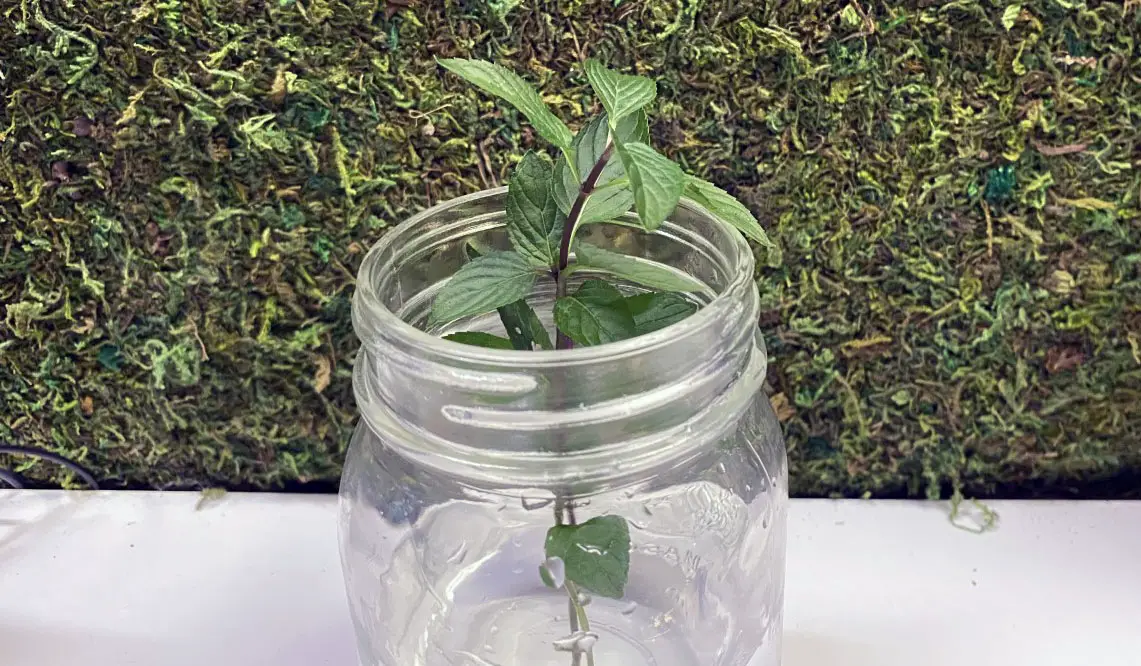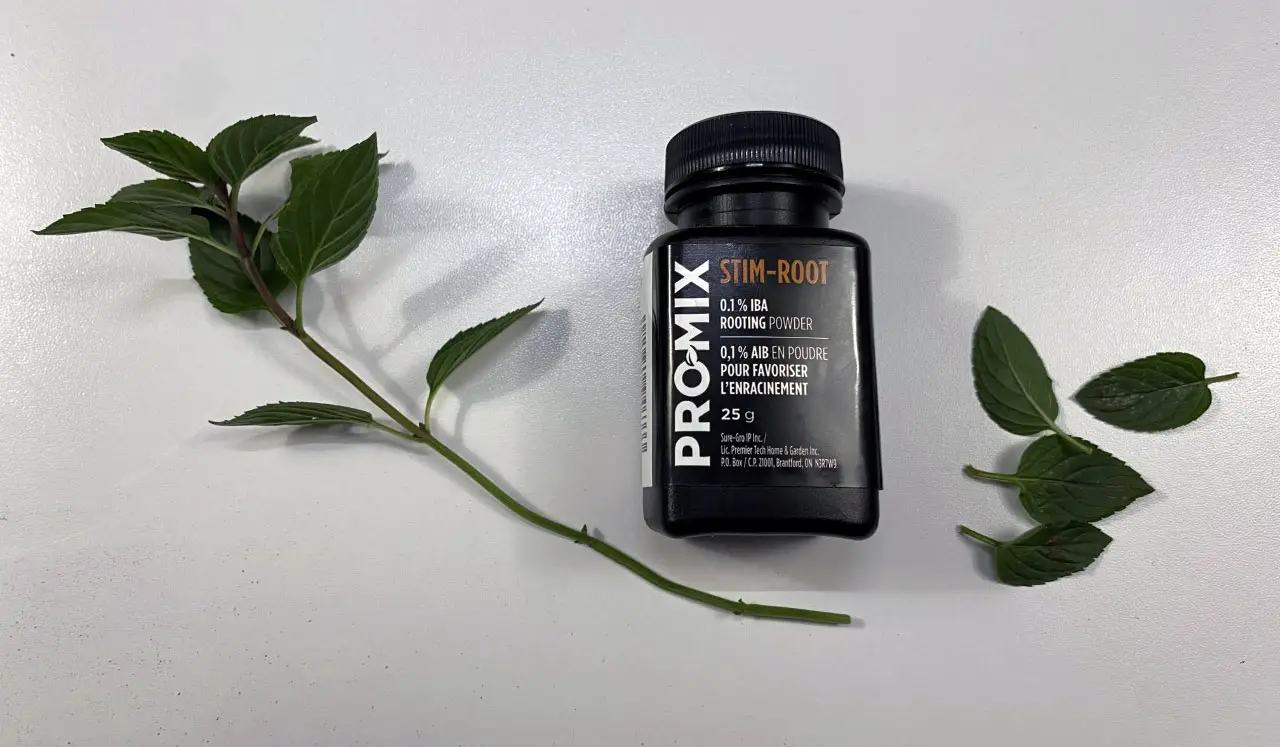6 Steps to Propagate Mint – How to Get Roots to Form Fast

This post follows our research editorial guidelines.

Can you grow mint from a cutting? Yes, you can. All you have to do is cut below the leaf node on the stem, stick it in some water, and watch the roots develop over the course of a few weeks. People tend to propagate their mint plants either because they want to find a more affordable alternative to expanding their collection, or because they want to save a plant that isn’t doing too well.

Table of Contents
Propagating is when you cut off a piece of an existing plant and place it in either soil or water until it develops roots and grows into a brand-new plant. But, propagating is kind of intimidating, right?
Especially if you haven’t done it before because you don’t want to accidentally make a mistake like cutting the stem in the wrong place. Trust me – I get it. I was so nervous the first time I did it, but believe me, it’s a very easy process once you do it.
If you’re ready to move forward with propagating your mint plant, we have a few tips for you to make the process as seamless as possible. As I said, I was really intimidated the first time I went to propagate one of my plants, but the process was way easier than I thought.
Plus, being able to see roots sprout from what once was a single cutting is so neat. I felt very proud of myself and with these tips, you will be too!
Here are six easy steps you can take to propagate your new mint plant.
1. Get Your Mint Cuttings

In order to propagate your mint, the first thing you have to do is get your cuttings. First, you’ll need the proper tools. Use either scissors or garden shears. I used scissors and didn’t run into any problems.
Make your cut right below the leaf node on the stem. The node is where new leaves emerge, so cutting it here ensures that you’ll see sufficient growth. Just remember to not leave a lot of space below the node because otherwise, the remainder of your stem will rot, causing the plant to no longer be viable. Generally speaking, you’ll want to cut your stem to about 3 inches.

2. Add Your Cuttings to a Jar of Water or Soil
When it comes to propagating not just a mint plant, but any plant, you have several options available depending on your preference. The most common form of propagation is to place your new cuttings into a jar or vase of water (I used a mason jar starting out).
Your clippings will start developing roots within a few weeks. I started seeing progress a few days in and now I have roots all over the bottom of my jar – it’s actually pretty surreal to see just how much they’ve grown in such a short period of time.
The other option, as mentioned above, is to plant your new cuttings in soil. For this method, all you have to do is add about 2 inches of soil to your pot, add your cuttings, cover the bottoms of your cuttings with soil and then water. Unlike propagation with water, this method takes a lot longer. It may be a few weeks before you start to see any progress.
There are some caveats to both methods, however. Typically, because potting soil has more nutrients in it, mint plants that are propagated in soil tend to be a lot stronger than those that only used water.
As such, if you used water, your mint plant may be a lot weaker when you go to transplant it to a real pot or in your garden. Because the soil method takes such a long time, many people opt for using water because they typically see results much sooner.
3. Add them to a Pot

If you only opted for using the water method, continue reading because this step doesn’t necessarily apply to those who opted for the soil method.
Your mint plant should be fully rooted within a month, and at that point, it’s time to transfer them over to a pot. If you leave them in water for too long, it can actually cause them to get water-logged and rot.
Remember, the mint plant’s roots are vital to the plant’s survival because it transfers nutrients through the stem. If the stem and roots are submerged in water too long, it ultimately causes them to drown and rot.
4. Add Compost or Fertilizer
Once you’ve potted your new mint plant, you should add either compost or fertilizer to the soil.
Composting is a great and easy way to add nutrients to your mint plant, including nitrogen which helps promote quicker and better plant growth. You don’t have to add a lot of compost or fertilizer to your pot, maybe only a ¼ or ½ an inch. Keep your new baby plant potted for about a week or so before transplanting it to its final location.
5. Keep the Soil Moist
Mint can thrive in all sorts of soil and weather conditions, but it does prefer moist soil. In fact, it hates dry soil.
Once you’ve added your new mint plant to a pot, make sure of two things. First, make sure that any water you use to hydrate the plant drains sufficiently and without issue. You can test this by seeing if water comes out of the drainage holes placed on the bottom of your pot. If water comes out, then the water drains without issue.
If it doesn’t, add a little bit of small rocks to your soil to break it up. If water can’t drain properly, it can lead to root rot.
Second, you have to make sure you keep the soil moist. Do a finger test. If the soil feels dry and crumbly to the touch, you need to add a little bit of moisture.
5. Trim The Top Growth To Prevent Flowering

When it comes to mint plants, the more you harvest them, the better they’ll grow, so take care to trim the top growth before you move it to its new location. This is done to help prevent flowering.
Though flowering is an essential part of the growing process, it can seriously reduce the quality of your mint leaves. By trimming them, you combat this and guarantee fresher, tastier, more effective mint leaves.
6. Transplant Your New Mint Plant to its New Location
Once you’ve taken all the steps outlined above, you’re ready to transfer it to its new location. Whether you’re just transferring it to a bigger pot or planting it outside, you’ll want to make sure that the root system is completely covered by enough topsoil and that it’s planted in a spot that gets a lot of sunshine, but a lot of partial shade, as well.
Speed Up Root Growth with Plant Hormones

Remember earlier we mentioned growing new roots with either water or soil? Well, there’s a third option you should consider too: plant hormones.
Plant hormones enact chemical changes in the plants. There are five common plant hormones:
- Ethylene
- Abscisic Acid
- Auxin
- Gibberellin
- Cytokinin
Auxin, for example, is known to stimulate plant growth. It does this by accelerating both cell growth and expansion inside the stem. Cytokinin, for example, is used to help develop new roots. As you can see, these growth hormones can be extremely viable when it comes to propagating mint clippings. In fact, according to a study conducted by and reported on by Eloise Foo, et al, “…auxin production has been suggested as an important mechanism through which microbes regulate plant growth.”
You can purchase plant hormones at your local retailer, plant shop, or online.
FAQ
Can I Propagate Store Bought Mint?
Yes, you can propagate store-bought mint. A lot of the same principles apply. Mint plants you buy from the produce section of your local grocery store are usually sold as cuttings or sprigs. This makes the process of propagating store-bought mint as seamless as doing it on your own.
It’s recommended that you transplant them as soon as you get them home from the supermarket so that it has a chance to grow and get used to the change in environment.
Grocery store mint isn’t taken care of with the same attention to detail that you would expect from a nursery. Grocery store plants are sold with the expectation that they won’t last long. While it’s certainly possible to propagate a store-bought mint plant, you do have to be careful.
The change from sitting in a grocery store with fluorescent lighting to natural sunlight can take a lot out of the mint plant. This is why it’s recommended that, if you plan on propagating the store-bought mint, you do it as soon as you get home from the grocery store to make it easier for the plant to adapt and grow.
Can Mint Grow in Just Water?
Yes, mint can grow in just water. I’ve done it myself! It really is as simple as placing mint in a jar of water and letting it grow. It’s recommended that you change the water and wash out the glass it’s growing in every 5 to 7 days.
The downside to this is that while it makes it easy to grow in a soil-less environment, mint doesn’t last forever in just water. At some point, its leaves will begin to yellow and it will no longer grow. However, you can have it live long enough to be able to harvest it and be able to propagate it regularly.
When planted, you’ll see that it will grow rather quickly, sprouting roots almost immediately. In the right conditions, it can become a full-grown plant within weeks or months, becoming viable with just a jar of water and some proper sunlight to maintain it.
As long as you keep it properly propagated and clean out the water and the jar regularly, you should be able to keep it alive for a while.
Does Mint Need Full Sun?
While mint can certainly grow in full sun, it’s actually preferred if it has some partial shade to grow in, especially if it’s being grown in a warmer region. Due to its nature of rapid growth, mint will tend to crawl toward sunlight if planted in a shady area. It’s recommended that you trim your mint plant on a regular basis to keep it from taking over other plants in your garden.
Full sun isn’t a necessity, but it’s also not a detriment. You should look into keeping it in partial shade, but if it’s not available to you, and you don’t live in a particularly hot environment, full sun will be okay to grow your mint in.
Final Thoughts
Propagating a mint plant is a great way to maintain a supply of your own mint without having to spend additional money. It’s a process that, if kept to, can be self-sustaining for quite some time. We recommend propagating mint if it’s an ingredient you use regularly.
